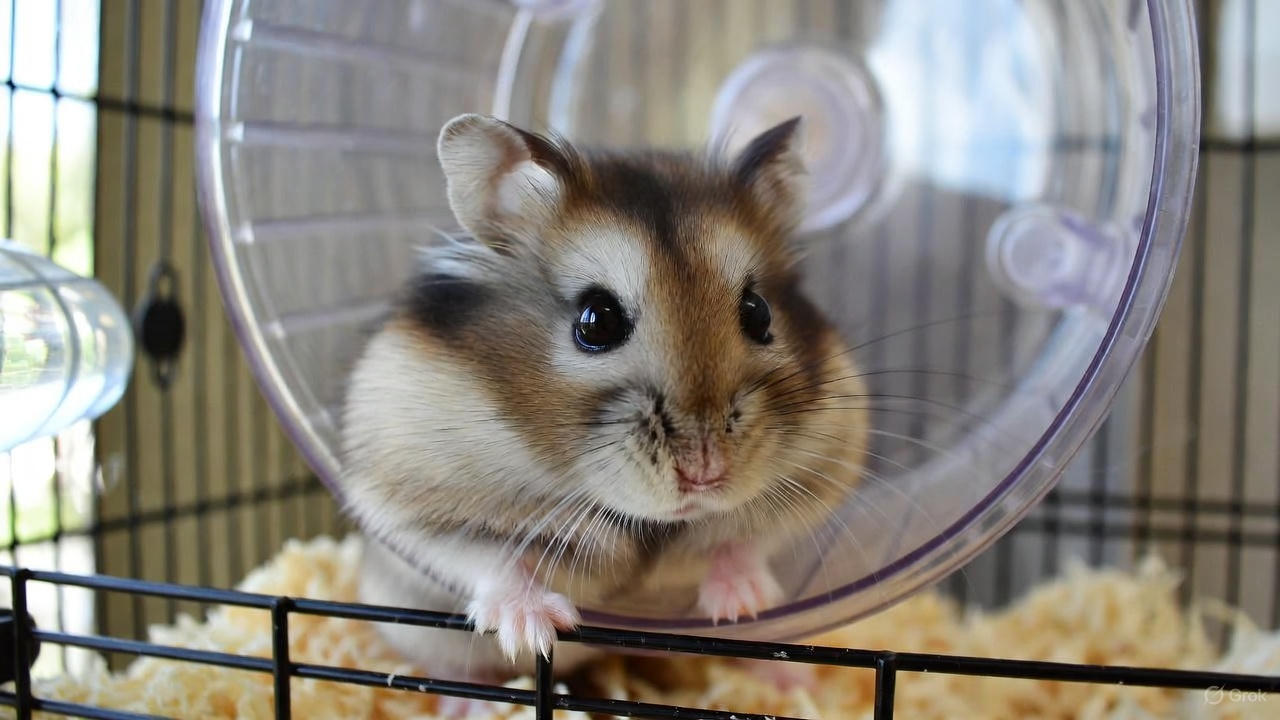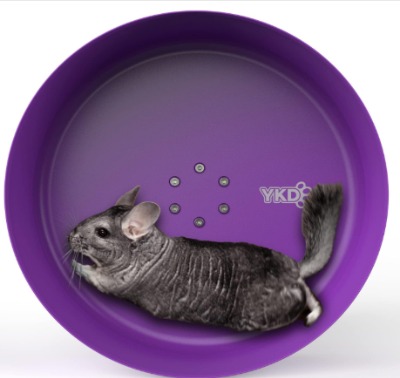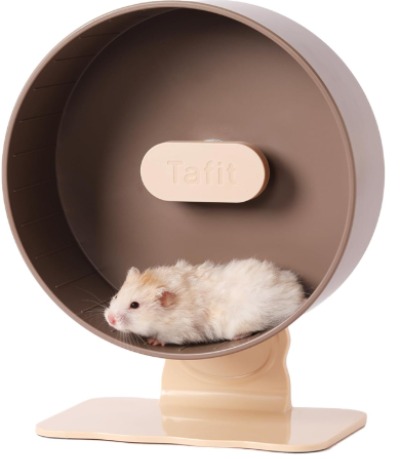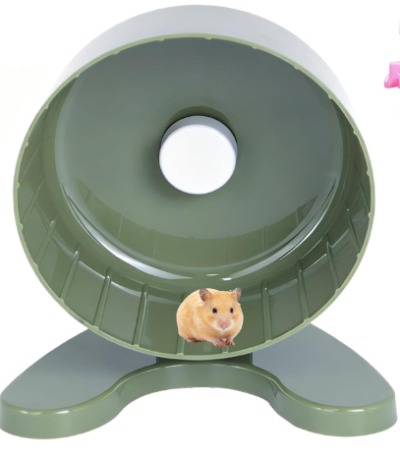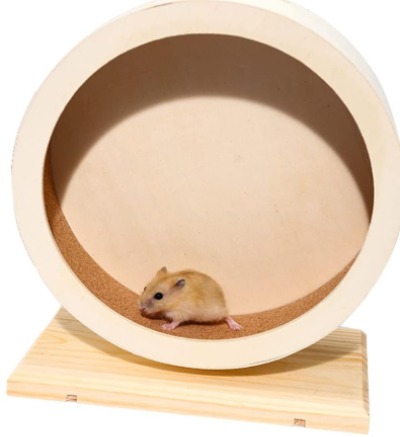5 Best Wheels for Syrian Hamsters In 2025
Syrian hamsters are active creatures that require proper exercise equipment to maintain their physical and mental well-being. A quality exercise wheel serves as essential habitat equipment that allows these energetic pets to fulfill their natural running instincts. Syrian hamsters can run several miles each night, making the right wheel crucial for their health and happiness.
Why Your Syrian Hamster Needs a Proper Exercise Wheel
Syrian hamsters are naturally active animals that travel long distances in the wild searching for food and exploring their territory. In captivity, they retain this instinct to run and explore. Without adequate exercise opportunities, these furry companions can develop behavioral issues, obesity, and stress-related problems.
An appropriate exercise wheel provides mental stimulation while keeping your pet physically fit. Running on a wheel helps hamsters release pent-up energy, reduces boredom, and prevents destructive behaviors like excessive bar chewing. The right wheel can make the difference between a happy, healthy hamster and one that develops health complications.
Critical Factors to Consider When Buying a Hamster Wheel
Size Matters Most
Syrian hamsters are the largest hamster species, requiring wheels with a minimum diameter of 8 inches. Many experts recommend 10 to 11 inches for adult Syrians. A wheel that’s too small forces your hamster’s back to curve unnaturally while running, leading to spinal problems and joint stress over time.
When your hamster runs, their back should remain straight or have only a slight natural arch. If you notice your pet’s back curving significantly, the wheel is too small. Larger wheels also provide more comfortable running surfaces and reduce the risk of injury.
Material Construction
Exercise wheels come in various materials, each with distinct advantages and drawbacks:
Plastic wheels are affordable, lightweight, and easy to clean. They come in multiple colors and styles. However, some hamsters chew through plastic, and lower-quality options may crack or warp over time.
Wooden wheels offer natural aesthetics and durability. They provide excellent grip and are harder to chew through compared to plastic. The downside is that wood absorbs odors and moisture, making thorough cleaning challenging. Some hamsters may develop allergies to certain wood types.
Metal wheels are the most durable option, resistant to chewing and easy to sanitize. They typically last longer than other materials but can be heavier and more expensive. Aluminum alloy wheels are particularly popular for larger animals.
Silent Operation
Hamsters are nocturnal creatures, meaning they’re most active when you’re trying to sleep. A noisy wheel can disrupt your rest and potentially stress your pet. High-quality wheels use ball bearings or magnetic axle systems to eliminate friction and ensure whisper-quiet operation.
Look for wheels described as “silent,” “ultra-quiet,” or featuring “dual ball bearings.” These designs allow your hamster to exercise throughout the night without creating disturbing squeaks or rattles.
Safety Features
Safety should never be compromised when selecting a hamster wheel. The running surface must be solid and continuous—avoid wheels with rungs, mesh, or gaps where tiny feet can get caught. These designs pose serious injury risks, including broken toes or legs.
The wheel should have a closed back to prevent your hamster’s tail from getting trapped. A stable base is essential to prevent tipping during vigorous running sessions. Some wheels offer both freestanding and cage-attachment options for versatility.
Ease of Maintenance
Regular cleaning prevents odor buildup and maintains a hygienic environment. Look for wheels that disassemble easily for thorough washing. Some designs allow quick removal of the wheel drum from the base, making cleanup simple.
Non-porous materials clean more effectively than absorbent ones. Smooth surfaces are easier to wipe down than textured options. Consider how often you’ll need to clean the wheel and how simple that process will be.
Top 5 Best Wheels for Syrian Hamsters: Detailed Reviews
1. FunstersTail Super Silent Hamster Wheel (8.7 Inch) – Tomato Red
Product Description
The FunstersTail Super Silent Hamster Wheel brings innovative magnetic axle technology to small pet exercise equipment. This 8.7-inch wheel features automotive-grade polycarbonate construction that resists scratches and maintains clarity even after repeated cleaning. The W-shaped ergonomic slope supports natural spine alignment, reducing joint stress during extended running sessions.
The magnetic hub design eliminates friction noise, making this wheel ideal for bedroom cage setups. The running surface is completely solid, protecting delicate paws from injury. The bright tomato red color adds a vibrant pop to any habitat while the transparent design lets you watch your pet in action.
This wheel works well for medium-sized Syrian hamsters and can accommodate other small animals like gerbils, chinchillas, and guinea pigs. The easy-disassembly feature allows for thorough cleaning in seconds without tools.
Key Features
- Magnetic axle system for friction-free, silent operation
- 8.7-inch diameter suitable for medium Syrians
- Automotive-grade PC material resists chewing
- W-shaped ergonomic running surface
- Tool-free disassembly for easy cleaning
- Multi-pet compatible design
Pros
- Exceptionally quiet operation perfect for light sleepers
- Scratch-resistant material maintains appearance
- Easy to clean with magnetic hub removal
- Ergonomic design reduces back strain
- Durable construction stands up to chewing
- Vibrant color options available
Cons
- May be slightly small for very large Syrian hamsters
- Freestanding only, no cage attachment option
- Higher price point than basic plastic wheels
- Magnetic system may weaken over extended use
- Limited color selection
Best For: Hamster owners who prioritize silent operation and modern design, particularly those with cages in bedrooms or living spaces where noise is a concern.
2. 15″ Silent Chinchilla Exercise Wheel – Aluminum Alloy (Purple)
Product Description
This premium 15-inch aluminum alloy wheel was designed with chinchillas in mind but works exceptionally well for Syrian hamsters who need extra space. The massive diameter ensures even the largest Syrian can run with a completely straight back, promoting optimal spinal health.
The wheel features stainless steel bearings for ultra-smooth, quiet spinning. Special anti-loosening screws prevent the wheel from developing noise over time—a common problem with lesser-quality wheels. The entire surface receives a non-toxic coating baked at ultra-high temperature, creating a wear-resistant, non-slip texture.
The frosted flat surface protects sensitive paws while providing excellent grip during fast runs. There are no splicing marks, welding seams, or sharp edges that could harm your pet. The aluminum construction won’t rust, making cleanup straightforward.
This wheel mounts directly to wire cages and works best on shorter cage walls for optimal stability. The 15-inch size provides ample running room, though it does require significant cage space.
Key Features
- Extra-large 15-inch diameter
- High-quality stainless steel bearings
- Aluminum alloy construction
- Non-toxic, heat-baked coating
- Anti-loosening screw system
- Wire cage mounting design
Pros
- Enormous size perfect for large Syrians
- Extremely durable aluminum construction
- Completely rust-proof for longevity
- Professional-grade bearings ensure quiet operation
- Anti-slip frosted texture provides excellent grip
- No welding marks or sharp edges
Cons
- Very large footprint requires spacious cage
- Cage-mount only, no freestanding option
- Higher price reflects premium construction
- Purple color may not suit all preferences
- Installation requires proper cage wire spacing
Best For: Owners of particularly large Syrian hamsters or those who want to provide maximum running space. Ideal for large wire cages with adequate room for this substantial wheel.
3. Quiet Hamster Wheel (10.2 Inch) – Dual-Bearings, Nut Brown
Product Description
This 10.2-inch wheel strikes an excellent balance between size and space efficiency. The dual-bearing design ensures smooth, silent rotation even during vigorous nighttime running sessions. The nut brown color provides a natural, earthy aesthetic that complements naturalistic habitat setups.
The height-adjustable stand accommodates different cage configurations and bedding depths. You can adjust the wheel’s position between low and high settings, ensuring proper entry access regardless of your substrate level. The wide, stable base prevents tipping during use.
The solid running surface protects tiny feet while the slight texture provides grip without being rough. This wheel works well for adult Syrian hamsters, gerbils, and rats. The plastic construction balances durability with lightweight portability.
The freestanding design allows placement anywhere in the cage, though some users report improved stability when placed on a platform. The simple assembly process doesn’t require special tools or complicated instructions.
Key Features
- 10.2-inch diameter for Syrian hamsters
- Dual-bearing silent operation
- Height-adjustable stand
- Solid, textured running surface
- Stable, wide base design
- Neutral nut brown coloring
Pros
- Ideal size for most Syrian hamsters
- Height adjustment accommodates different setups
- Silent operation with quality bearings
- Natural color blends with habitat decor
- Stable base resists tipping
- Reasonably priced for features offered
Cons
- Plastic construction less durable than metal
- Some assembly required
- Freestanding only, no attachment option
- May require platform placement for best stability
- Limited color choices
Best For: Hamster owners seeking a reliable, properly-sized wheel with adjustability features at a moderate price point. Great for standard Syrian hamsters in medium to large cages.
4. 6.5″ Super Silent Hamster Wheel with Stand & Water Bottle – Green
Product Description
This compact all-in-one solution combines a 6.5-inch exercise wheel with an integrated water bottle system. The space-saving design works well for smaller cages where every inch counts. The ultra-quiet spinning mechanism uses advanced bearing technology to eliminate noise.
The green color brings a fresh, natural look to your hamster’s home. The included water bottle mounts directly to the stand, creating a tidy, organized setup. This wheel is better suited for dwarf hamsters or young Syrian hamsters rather than full-grown adults.
The noiseless design makes this wheel popular among apartment dwellers and light sleepers. The solid running surface prevents foot injuries while the open-side design allows easy entry and exit. The stand provides stable support without taking up excessive floor space.
This budget-friendly option includes everything needed to get started. The water bottle holder adjusts to different heights, and the bottle itself holds enough water for several days depending on your hamster’s size.
Key Features
- 6.5-inch wheel with integrated water bottle
- Ultra-quiet spinning design
- Space-efficient combined system
- Solid, safe running surface
- Adjustable water bottle holder
- Complete setup included
Pros
- Space-saving all-in-one design
- Includes water bottle and holder
- Very quiet operation
- Budget-friendly pricing
- Easy to set up and use
- Compact footprint for smaller cages
Cons
- Too small for adult Syrian hamsters
- Water bottle may need frequent refilling
- Plastic construction less durable
- Green color may not appeal to everyone
- Limited to younger or smaller hamsters
Best For: Owners of dwarf hamsters, young Syrians, or those with space constraints who need a combination wheel and water system. Not recommended for full-grown Syrian hamsters.
5. antiai Hamster Wooden Silent Wheel (8.2″ Medium Size)
Product Description
The antiai wooden wheel brings natural materials and aesthetic appeal to hamster exercise equipment. This 8.2-inch wheel features high-quality wood construction with a cork running surface that provides excellent traction. The natural materials create an attractive, eco-friendly option for naturalistic habitat setups.
The dual ball-bearing system ensures quiet operation despite the wooden construction. The wheel spins smoothly and remains stable even during energetic running. The non-tipping stand features a widened, thickened wood base that provides reliable support.
The cork surface feels natural under hamster paws and offers superior grip compared to plastic or metal surfaces. The wood construction is harder to chew through than plastic, though determined chewers may still leave marks. This wheel works well for dwarf hamsters and smaller Syrian hamsters.
The natural aesthetic appeals to owners who prefer earth-tone decor and eco-conscious products. The wooden materials are non-toxic and safe if chewed. However, wood requires more careful cleaning than plastic or metal alternatives.
Key Features
- 8.2-inch diameter wooden wheel
- Natural cork running surface
- Dual ball-bearing mechanism
- Widened, stable wood base
- Eco-friendly materials
- Chew-resistant construction
Pros
- Beautiful natural wood aesthetic
- Cork surface provides excellent grip
- Quiet operation despite wood construction
- Eco-friendly, non-toxic materials
- Very stable base prevents tipping
- Harder to chew than plastic wheels
Cons
- Wood absorbs odors and moisture
- Difficult to thoroughly clean
- Not suitable for hamsters that urinate on wheels
- May be too small for large adult Syrians
- Cork surface can deteriorate over time
- Higher maintenance than plastic options
Best For: Owners who prioritize natural materials and aesthetics, particularly those with naturalistic habitat setups. Best for hamsters that don’t toilet in their wheels.
Comparing the Top Five Wheels
When examining these five options side by side, several patterns emerge. The aluminum alloy chinchilla wheel offers the largest running surface, making it perfect for oversized Syrian hamsters or those who simply want maximum space. However, this size comes with increased cage space requirements and a higher price tag.
The FunstersTail magnetic wheel represents modern engineering applied to small pet equipment. Its innovative friction-free design and scratch-resistant materials appeal to tech-savvy pet owners. The 8.7-inch size works well for average Syrians but may be limiting for larger individuals.
The 10.2-inch dual-bearing wheel occupies a middle ground, offering generous size without the space demands of the 15-inch option. Its adjustable height feature provides versatility that the other wheels lack. The natural brown color creates a subtle, attractive look.
The combination wheel with water bottle maximizes functionality in minimal space. However, its 6.5-inch diameter makes it unsuitable for adult Syrian hamsters. This option serves best as a starter wheel for young hamsters or a permanent solution for dwarf species.
The antiai wooden wheel stands out for its natural materials and attractive appearance. Pet owners who create elaborate, naturalistic habitats will appreciate this wheel’s aesthetic contribution. The trade-off comes in maintenance requirements and cleaning challenges.
Size Guide: Finding the Perfect Fit for Your Syrian Hamster
Syrian hamsters vary significantly in size. A petite female might measure 5 inches in body length while a robust male could reach 7 inches. This variation means wheel size recommendations must consider individual body proportions rather than relying solely on species designation.
For Syrians measuring 5 to 6 inches, an 8 to 9-inch wheel provides adequate running room. Most hamsters in this size range will maintain a straight back on wheels in this diameter range. The FunstersTail and antiai wheels fall into this category.
Hamsters measuring 6 to 7 inches benefit from 10 to 11-inch wheels. This size allows comfortable running with proper spinal alignment. The 10.2-inch adjustable wheel serves this group well.
Large Syrians over 7 inches require 11 to 12-inch wheels minimum. Some particularly substantial individuals may need even larger options. The 15-inch aluminum wheel ensures these big hamsters have ample space.
To measure your hamster, observe them while they’re relaxed and stretched out. Measure from nose tip to rump, excluding the tail. Use this measurement to select an appropriately-sized wheel that allows natural running posture.
Material Comparison: Plastic vs. Wood vs. Metal
Each wheel material offers distinct characteristics that affect performance, maintenance, and longevity. Understanding these differences helps you make an informed decision based on your priorities and circumstances.
Plastic Advantages and Drawbacks
Plastic wheels dominate the market due to affordability and variety. Modern plastics resist cracking and maintain structural integrity during normal use. They clean easily with soap and water, don’t absorb odors, and come in numerous colors.
The downside involves durability concerns with aggressive chewers. Some hamsters gnaw plastic wheels relentlessly, creating rough edges or holes. Lower-quality plastics may warp or crack over time. UV exposure from windows can cause deterioration in some formulations.
Wood Characteristics
Wooden wheels appeal to owners prioritizing natural aesthetics. Quality hardwoods resist chewing better than plastic and provide excellent grip. The natural materials blend beautifully with naturalistic habitat designs.
Maintenance challenges arise from wood’s porous nature. It absorbs urine, feces, and moisture, creating odor problems. Deep cleaning requires special techniques—simple soap and water aren’t sufficient. Some hamsters develop sensitivities to certain wood types. Cork surfaces deteriorate with heavy use and may need replacement.
Metal Benefits and Limitations
Metal wheels, particularly aluminum alloy options, represent the most durable choice. They withstand chewing, don’t crack or warp, and last for many hamster lifetimes. Metal surfaces clean thoroughly without absorbing odors or stains.
The weight of metal wheels provides stability but makes them harder to move. Installation typically requires more secure mounting than lighter options. Price points run higher, though the extended lifespan often justifies the investment. Some metals can develop rust if not properly treated, though aluminum alloys avoid this issue.
Noise Level Considerations
The sound generated by exercise wheels significantly impacts household harmony. Syrian hamsters run extensively at night, making quiet operation essential for human sleep quality and hamster stress reduction.
Traditional wheel designs create noise through several mechanisms. The axle rotating against the mounting point generates friction sounds. The wheel drum hitting the stand creates rhythmic tapping. Loose components rattle or squeak during use.
Modern silent wheels address these issues through improved engineering. Ball-bearing systems minimize friction by allowing smooth rotation. Some designs use dual bearings that completely eliminate axle noise. Magnetic axle systems, like the FunstersTail uses, prevent metal-on-metal contact altogether.
Proper assembly and maintenance affect noise levels. Tightening loose screws eliminates rattles. Periodic lubrication of moving parts prevents squeaks. Some wheels develop noise over time as components wear—addressing this early prevents sleep disruption.
Even “silent” wheels aren’t completely soundless. You’ll hear your hamster’s footsteps on the running surface. Faster runners create more noise regardless of wheel quality. Placing the wheel on a platform rather than directly on bedding can reduce sound transmission.
Installation and Assembly Tips
Setting up your hamster wheel correctly ensures safety and optimal performance. Most wheels arrive requiring some assembly, though complexity varies by model.
Start by unpacking all components and checking against the included inventory list. Missing parts should be reported to the manufacturer immediately. Read instructions completely before beginning assembly—this prevents common mistakes.
For freestanding wheels, attach the running drum to the base according to directions. Tighten all screws firmly but avoid over-tightening, which can crack plastic components or strip threads. The wheel should spin freely without wobbling or resistance.
Test the wheel’s stability before introducing your hamster. Press down on different areas to check for tipping. Wheels that rock or feel unstable need adjustment. Some models include non-slip pads or cork pieces for the base—use these to prevent sliding.
Position the wheel away from water bottles, food dishes, and hiding spots. Hamsters need clear access from multiple angles. Ensure adequate clearance above the wheel for your hamster’s height. The running surface should sit low enough for easy entry but high enough to stay above deep bedding.
For cage-mounted wheels, identify appropriate attachment points on your wire cage. The wheel should mount securely without excessive movement. Follow manufacturer spacing recommendations between bars. Test the attachment by spinning the wheel vigorously—it shouldn’t shift or loosen.
Maintenance and Cleaning Guidelines
Regular maintenance extends wheel lifespan and maintains hygienic conditions. Most wheels need cleaning weekly, though frequency depends on your hamster’s habits and cage cleaning schedule.
For routine cleaning, remove the wheel from the cage. Disassemble removable components according to manufacturer instructions. Wipe solid surfaces with pet-safe disinfectant or mild soap solution. Avoid harsh chemicals that could leave harmful residues.
Plastic wheels tolerate most cleaning methods. Rinse thoroughly with warm water after using cleaning products. Air dry completely before reassembly. Check for cracks or rough spots that could injure your hamster—sand smooth or replace damaged wheels.
Wooden wheels require gentler cleaning approaches. Avoid soaking, which damages wood and cork. Instead, scrape off solid waste with a small brush or scraper. Spot clean with slightly damp cloths. For persistent odors, leave the wheel in sunlight for several hours—UV light naturally kills bacteria.
Metal wheels handle aggressive cleaning well. Scrub with stiff brushes to remove stuck-on debris. Most metal wheels can withstand complete submersion in cleaning solutions. Dry thoroughly to prevent water spots or oxidation.
Inspect bearings during cleaning. They should spin freely without grinding or resistance. Sticky bearings may need lubrication—use food-grade mineral oil or products specifically designed for pet equipment. Never use WD-40 or similar products that could harm your hamster.
Common Problems and Solutions
Even high-quality wheels occasionally develop issues. Recognizing and addressing these problems quickly prevents frustration and ensures your hamster’s exercise needs are met.
The Wheel Wobbles
Wobbling typically indicates loose screws or uneven base placement. Tighten all fasteners and verify the wheel sits on a level surface. Some wheels wobble on thick bedding—place a solid platform underneath to provide stability.
Increasing Noise Over Time
Wheels that were once quiet but become noisy usually need maintenance. Check for loose components and tighten as needed. Clean and lubricate bearings. Worn bearings may require replacement for optimal quietness.
Hamster Won’t Use the Wheel
Some hamsters need encouragement to use new wheels. Try placing favorite treats inside or near the wheel. Gently place your hamster on the wheel during active periods. Patience helps—some hamsters take several days to accept new equipment.
If your hamster used a wheel previously but stopped, the wheel may be too small. Watch your hamster’s posture on the wheel. A curved back indicates the need for a larger size.
Wheel Tipping Over
Lightweight wheels on uneven surfaces tip easily. Add weight to the base using aquarium-safe materials or place the wheel on a stable platform. Some owners attach small weights to the stand for added stability.
Chewing Damage
Hamsters sometimes chew wheel components, creating rough edges or holes. Inspect regularly for damage. File rough spots smooth or replace damaged parts. Switch to metal or hardwood wheels if chewing becomes persistent.
Safety Checklist for Hamster Wheels
Before allowing your hamster to use any wheel, verify it meets essential safety standards:
- The running surface is completely solid with no gaps, slots, or mesh
- The back is closed to prevent tail entrapment
- All edges are smooth with no sharp points or rough areas
- The wheel has no exposed screws or hardware inside the running area
- The diameter is appropriate for your hamster’s size
- The wheel sits stable without excessive wobbling
- Moving parts operate smoothly without grinding or sticking
- Materials are non-toxic and safe if chewed
- The wheel base prevents tipping during vigorous use
- Assembly is secure with no loose components
When to Replace Your Hamster Wheel
Even durable wheels eventually need replacement. Watch for these signs indicating it’s time for a new wheel:
Visible cracks or breaks in the running surface pose injury risks. Replace immediately rather than attempting repairs. Worn bearings that no longer spin smoothly prevent proper exercise. Persistent odors that don’t resolve with cleaning suggest material degradation.
Excessive wobbling or instability that can’t be corrected through tightening indicates structural problems. Noise that returns immediately after maintenance suggests worn components. Size-related issues develop as hamsters grow—what fit a juvenile may be too small for an adult.
Most plastic wheels last 1 to 2 years with proper care. Wooden wheels vary widely based on usage and maintenance—some last years while others deteriorate quickly. Metal wheels often outlast multiple hamsters when properly maintained.
Budget Considerations
Hamster wheels range from budget options under 15 dollars to premium models exceeding 50 dollars. Price differences reflect material quality, engineering sophistication, and durability expectations.
Budget wheels serve adequately for temporary situations or very young hamsters that will soon need larger sizes. They typically use basic plastic construction with simple axle designs. Noise levels vary, and longevity is limited.
Mid-range wheels, typically 20 to 35 dollars, offer better materials and improved bearing systems. These wheels balance affordability with decent quality and longer lifespan. Most pet owners find this price range provides good value.
Premium wheels command higher prices through superior materials, advanced engineering, and exceptional durability. Metal and specialty wheels fall into this category. While expensive initially, they often prove economical long-term through extended use.
Consider your hamster’s expected lifespan when budgeting. Syrian hamsters typically live 2 to 3 years. Investing in a quality wheel that lasts your hamster’s lifetime makes more sense than repeatedly replacing cheap options.
Making Your Final Decision
Selecting the best wheel for your Syrian hamster involves weighing multiple factors against your specific situation. Start by accurately measuring your hamster to determine appropriate wheel diameter. Syrian hamsters generally need 8 to 11 inches, with larger individuals requiring bigger options.
Consider your living situation and noise sensitivity. If the cage sits in your bedroom, prioritize silent operation through magnetic or premium ball-bearing designs. Household members with different sleep schedules benefit from the quietest wheels available.
Evaluate your hamster’s personality and habits. Heavy chewers need metal or hardwood wheels that resist destruction. Hamsters that toilet in their wheels require easy-to-clean plastic or metal rather than absorbent wood.
Think about cage space and mounting preferences. Large cages accommodate bigger wheels that provide optimal running room. Small cages may require compact designs or combination units that maximize limited space.
Your aesthetic preferences matter too. Naturalistic habitats look best with wooden wheels in earth tones. Modern, minimalist cages might suit clear acrylic or brightly colored options. Some owners prioritize function over appearance—either approach is valid.
Budget realistically for both initial purchase and potential replacements. A quality wheel represents an investment in your hamster’s health and wellbeing. Cheap wheels that need frequent replacement ultimately cost more than buying a good wheel initially.
Conclusion
The five wheels reviewed here represent excellent options for Syrian hamster owners with different priorities and situations. The FunstersTail magnetic wheel excels in silent operation and modern engineering. The 15-inch aluminum wheel provides maximum space for large hamsters. The 10.2-inch adjustable wheel offers versatility and appropriate sizing for most Syrians.
The combination wheel suits space-constrained setups and younger hamsters, though it’s too small for adult Syrians. The antiai wooden wheel appeals to natural aesthetics enthusiasts willing to manage the extra maintenance requirements.
For most Syrian hamster owners, the 10.2-inch dual-bearing wheel provides the best balance of size, features, and value. It fits the majority of adult Syrians comfortably while remaining affordable and relatively easy to maintain.
Large hamster owners should seriously consider the 15-inch aluminum option despite its higher price and space requirements. The investment in your hamster’s spinal health pays dividends through reduced injury risk and better quality of life.
Owners prioritizing absolute silence might prefer the FunstersTail magnetic design, particularly if bedroom proximity makes noise a serious concern. The innovative friction-free system delivers impressively quiet operation.
Natural habitat enthusiasts will appreciate the antiai wooden wheel’s aesthetic contribution, provided they accept the maintenance challenges. This wheel works best for hamsters that don’t toilet in their wheels and owners willing to invest extra cleaning effort.
Remember that the “best” wheel ultimately depends on your specific hamster’s size, your cage setup, noise sensitivity, and personal preferences. Any of these five options can serve well in appropriate circumstances. Focus on proper sizing, safety features, and quality construction regardless of which model you choose.
Your Syrian hamster deserves exercise equipment that supports natural behavior while protecting their physical health. The right wheel becomes a beloved part of their daily routine, contributing to a long, healthy, and happy life in your care.

